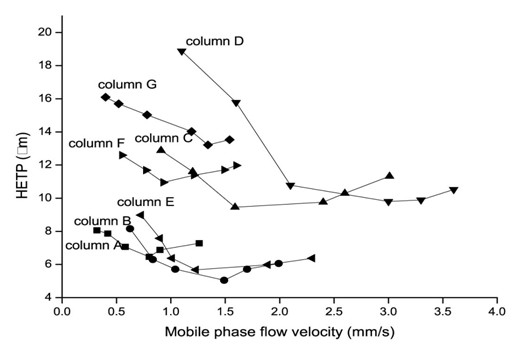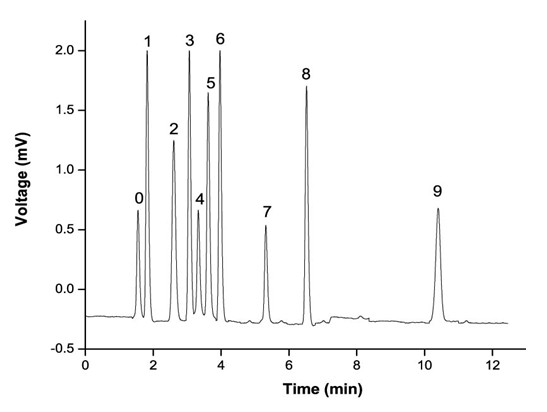Multi-action mode hydrophilic organic polymer monolithic column
A hydrophilic organic, monolithic column technology, applied in the field of analytical chemistry, can solve problems such as application limitations, and achieve the effects of increasing dosage, enriching π-π interaction, and increasing solubility
- Summary
- Abstract
- Description
- Claims
- Application Information
AI Technical Summary
Problems solved by technology
Method used
Image
Examples
Embodiment 1
[0020] Ionic monomer: N,N,N-trimethylvinylbenzyl ammonium chloride, crosslinker: tris-2-acrylic acid[2,4,6-trioxo-1,3,5-triazine -1,3,5(2H,4H,6H)-methine]tri-2,1-ethylene ester, initiator: azobisisobutyronitrile, mixed porogen: mass ratio of methanol to dodecanol Prepared according to the following data respectively:
[0021] Column A: crosslinker 9%, ionic monomer: 11%, dodecanol: 35%, methanol: 44%, initiator 1%.
[0022] Column B: crosslinker 9%, ionic monomer: 11%, dodecanol: 38%, methanol: 41%, initiator 1%.
[0023] Column C: crosslinker 9%, ionic monomer: 11%, dodecanol: 41%, methanol: 38%, initiator 1%.
[0024] Column D: crosslinker 9%, ionic monomer: 11%, dodecanol: 44%, methanol: 35%, initiator 1%.
[0025] Column E: crosslinker 10%, ionic monomer: 10%, dodecanol: 38%, methanol: 41%, initiator 1%.
[0026] Column F: crosslinker 8%, ionic monomer: 12%, dodecanol: 38%, methanol: 41%, initiator 1%.
[0027] Column G: crosslinker 7%, ionic monomer: 13%, dodecanol: ...
Embodiment 2
[0030] Using the monolithic column B prepared above, using acetonitrile:ammonium formate buffer (5mmol / L, pH 4.5)=90:10 as the mobile phase, separation voltage +18 kV, the nucleosides and bases were separated by capillary electrochromatography, Under the joint action of hydrophilic interaction, π-π interaction and electrostatic interaction provided by the monolithic column, 9 nucleosides and bases were quickly separated, and the elution peaks were as follows: 1. Uracil, 2. Adenine, 3. Uridine, 4. Adenosine, 5. Inosine, 6. Cytosine, 7. Guanine, 8. Cytidine, 9. Guanosine.
PUM
 Login to View More
Login to View More Abstract
Description
Claims
Application Information
 Login to View More
Login to View More - R&D
- Intellectual Property
- Life Sciences
- Materials
- Tech Scout
- Unparalleled Data Quality
- Higher Quality Content
- 60% Fewer Hallucinations
Browse by: Latest US Patents, China's latest patents, Technical Efficacy Thesaurus, Application Domain, Technology Topic, Popular Technical Reports.
© 2025 PatSnap. All rights reserved.Legal|Privacy policy|Modern Slavery Act Transparency Statement|Sitemap|About US| Contact US: help@patsnap.com


